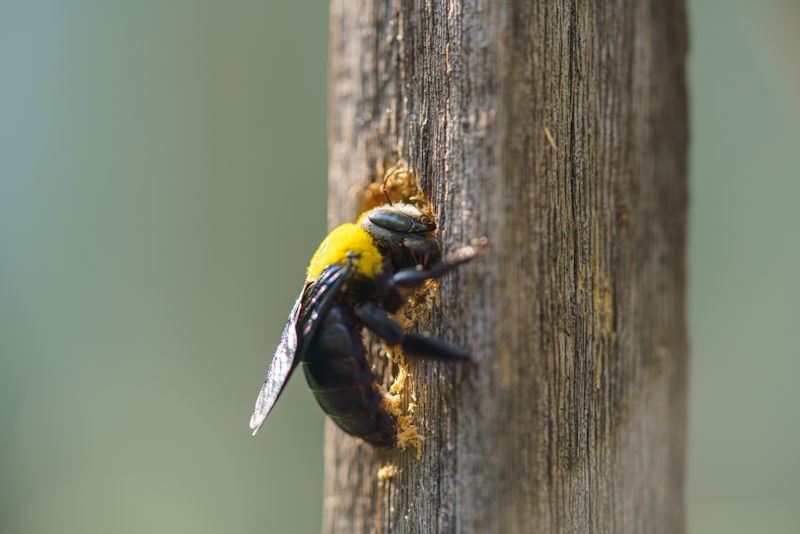Introduction
Carpenter bees may look like bumblebees, but they can be a big problem for homeowners. These bees dig holes in wood to make nests, which can weaken wooden structures over time. If you live in Southern Maryland or Northern Virginia, carpenter bees could be damaging your home or outbuildings. Learn how to protect your property with these simple prevention and control tips.
How to Keep Carpenter Bees Away
1. Seal Off Entry Points
Carpenter bees prefer to nest in exposed wood, like eaves, decks, and fascia boards. Here’s how to stop them:
- Inspect Your Home: Look for round holes or damaged wood.
- Seal Holes: Fill them with caulk or wood putty.
Protect Wood: Paint or varnish exposed surfaces. Treated or painted wood is less attractive to carpenter bees.
2. Treat Wood Properly
- Use Sealants or Paint: Add a fresh coat of paint or wood sealant to make surfaces less appealing.
- Try Borate Wood Preservatives: These treatments protect untreated wood and stop bees from burrowing.
3. Add Physical Barriers
- Install Screens: Place fine mesh screens over vents, soffits, and other openings.
- Upgrade Materials: Replace wood with bee-resistant options like vinyl or aluminum siding.
- Use Insect Netting: Cover vulnerable wood during the peak spring season.
Reduce Bee-Friendly Conditions
4. Keep Up with Maintenance
- Repair cracks or holes in wood.
- Replace weak or rotting wood.
- Maintain a regular schedule to check and treat wooden structures.
5. Control Moisture
Excess water weakens wood, making it easier for carpenter bees to bore through.
- Fix Drainage Issues: Keep gutters clear and water flowing away from your home.
- Improve Ventilation: Ensure proper airflow to reduce moisture.
6. Smart Landscaping
- Plant Bee-Repellent Plants: Add citronella, eucalyptus, or mint around your home.
- Clear Woodpiles: Keep logs, stumps, and dead trees far from your house.
Use Preventative Products
Apply commercial products like insecticidal sprays or dusts with active ingredients such as permethrin or cyfluthrin. Follow the product’s instructions for safe and effective use.
When to Call a Professional
Signs of a Severe Infestation
- Multiple round holes in wood
- Piles of sawdust (called frass) beneath holes
- Lots of carpenter bees flying near your home
Why Call a Professional?
- Experts use stronger treatments like insecticidal dust injected into tunnels.
- They can identify all nesting areas and provide long-term solutions.
- Professionals offer follow-up services to prevent future infestations.
Finding the Right Pest Control Company
- Look for experienced companies with good reviews.
- Ask for a detailed treatment plan and references before hiring.
Monitor and Maintain Your Home
Regular Inspections
Check your property twice a year, especially in early spring and late summer when carpenter bees are most active. Look for new holes, sawdust, or bee activity.
Use Bee Traps
Set up traps designed for carpenter bees to monitor their presence and reduce their population.
FAQs About Carpenter Bees
Q: What attracts carpenter bees to my house?
A: Carpenter bees love untreated or weathered wood, especially softwoods like pine and cedar.
Q: Are carpenter bees dangerous?
A: They rarely sting, but their nesting can cause serious structural damage
Q: How can I spot an infestation?
A: Look for round holes in wood, sawdust piles, and large bees hovering around your home.
Q: Can I get rid of carpenter bees myself?
A: Yes, for small infestations. For severe cases, it’s best to hire a professional.
Q: How often should I inspect for carpenter bees?
A: At least twice a year, especially during their active seasons in spring and late summer.
Conclusion
Keeping carpenter bees off your home takes effort, but it’s worth it. Seal up holes, treat and protect wood, and monitor activity regularly. For severe problems, don’t hesitate to contact professional pest control services. With the right steps, you can protect your home and enjoy peace of mind.
References
- Preliminary Evaluation of Exclusion as a Technique to Reduce Carpenter Bee Damage
- Nectar-Robbing Carpenter Bees Reduce Seed-Setting Capability of Honey Bees
NEED HELP?
If you live in Southern Maryland, or Northern Virginia
FIND YOUR SOLUTION HERE
People, Pet & Pollinator Safe! Pest control for people who care.
